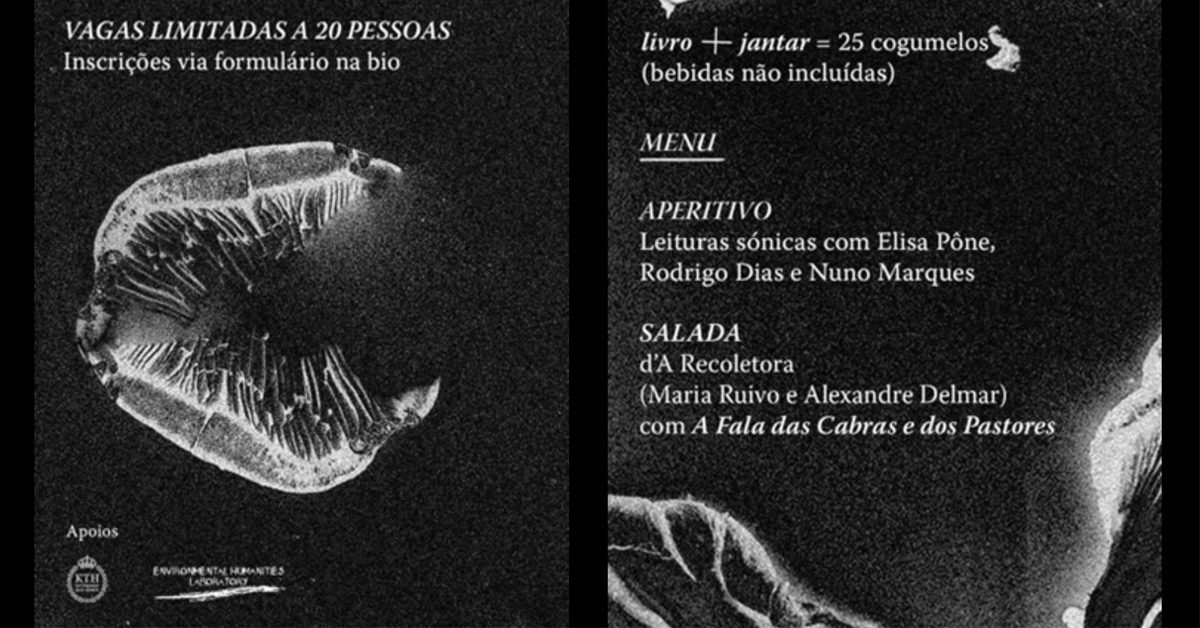EHL's postdoc Nuno Marques shares about some of his collaborations on ecopoetics

Nuno Marques, a postdoc at the EHL working on ecopoetics, explores connections between poetics and sciences, particularly ecology, climatology, and meteorology in the environmental humanities. As part of this research, Nuno collaborates with artists as a researcher, translator and poet. This spring, the EHL supported two collaborations: two performances on poetry about food and ecology and an open talk about techno forests. Below, Nuno shares about the events.
What are we Eating?
This March, I presented my Portuguese translation of John Cage's poem from 1975 Where Are We Eating? and What Are We Eating? (38 Variations on a Theme by Alison Knowles) - Onde é Que Estamos a Comer? e O Que é Que Estamos a Comer? (38 Variações sobre um Tema de Alison Knowles). John Cage was an experimental composer and poet whose work often addressed technology and science, including ecology. Cage's text includes:
- He begins with an introduction explaining why and how he started a macrobiotic diet and then moves on to 38 poems, or variations, that combine food, ecology, and environmental politics.
- Communication within the Merce Cunningham dance company.
- Discussions of form and artistic practice.
- Mushrooms, Buddhism, recipes, friendship.
They give an insight into Cage's ecological thinking, contemporary anarchist movements, the use of technology in communication, and his composition methods.
Taking a cue from Cage's influential role in contemporary art, music, performance, and poetics, the book was presented on two different occasions: one in Lisboa at Casa do Comum and the other in Porto at Performing the Archive . Elisa Pône , Rodrigo Dias and I performed sonic readings on both occasions, and João dos Santos Martins gave a short lecture about Merce Cunningham in Portugal.
The presentation in Porto was the opportunity for a performance dinner cooked by Portuguese and French artists, musicians, performers, researchers, architects, curators, ruderal plant pickers, and others.
The dinner performance had the following menu:

Appetizer
sonic readings by Elisa Pône , Rodrigo Dias and nuno marques .
Salad
made by A Recoletora ( Maria Ruivo and Alexandre Delmar ) screening A Fala das Cabras e dos Pastores (The Speech of Goats and Goatherds).

Main Course
Paulo Vinhas — rice with wild mushrooms; Joaquim Moreno — black rice, pleurotus and black beans; presentation Merce Cunningham in Portugal by João dos Santos Martins and Can I have seconds by Filipe Felizardo .
Dessert
By Paula Pinto and Rita Barreira with audio piece A Grande Sucessão by Landra (Sara Rodrigues and Rodrigo Camacho) with tibicos (water kefir) from roots of pioneer plants and acorn infusion.
During the dinner performance people could learn about other people’s works and discuss artistic practices and environmentalism. Some of the presentations and enactments included interspecies communication forms by Portugues shepherds; alternative recipes and distillation processes using ruderal plants, and the making of pickle of Cage’s book to reflect on time and the duration of food and materials.
Between the Alameda and the Atlantic Forest: daily life, passages and pilgrimages
This spring I also took part ina collective talk about the psychogeography of the artist Xavier Ovídio at the Portuguese National Museum of Natural History and Science , with Rita Barreira , a researcher at the Institute of Art History, NOVA- FCSH, Paulo Marques , curator of the Natural Sound Archive, National Museum of the Natural History and Science, and Xavier Ovídio.
In this talk, we discussed techno/eco/poetics of the Anthropocene based on Ovídio’s exhibition in that museum, which included a sound installation of city noises modulated as bird’s songs, canvases depicting the Atlantic Forest and notations of bird songs. We discussed some of the materials of this poetics, such as plastic and its long temporality; and how the work addressed technonature, extinctions, extractivism and the deforestation of the Atlantic Forest. Rita Barreira reflected on the critical route implicated in the exhibition space arguing that instead of a transparent everyday life, the visual and sound repetition of Lisbon's day-to-day life is recombined and signified in a detour by the notes of perception, in the piece “Clareira adentro” (“into the woods”). This city as transformed woods, which I proposed as a techno forest, is composed of the sculptures Barreira argued are locations (signposts and stop stations) made from the leftovers of evictions, urban refurbishments and biennial exhibitions. Discussing this thin margin between natural and artificial, Paulo Marques argued that sonic natural landscapes have been understood to include social elements, and the Museum collection of sounds includes them.
In the exhibition, this tecnhoforest was dramatised by the sonic piece making the city birds migrate Lisbon's noise in this flight to an encounter with the Woods, the Forest, and the Galician woodlands. Barreira also showed the relationship between these transformed environments and the rights of housing and of inhabiting a place. The materials of Ovídio's work are the everyday life and what is left over from the work of living, of assembling and disassembling, of the accelerated pendulums between artistic residencies, and the construction of stop stations, reflection and criticism, of artistic practice as a leftover. Thus, she also talked about losses and departures, when staying is no longer a right, and being able to stay becomes a luxury. During the final reflection, we discussed relations between arts and science in environmental issues. Because the exhibition was at the Museum of Natural History and Science it also related to the history of the relationship between culture and nature made through natural sciences. The interpretation and measurement of nature go hand in hand with its transformation, but narratives, poetry and arts create embodied knowledge that affects others and can promote critical complements to scientific knowledge.
The performances and the open talk were international collaborations between artists and researchers, as part of Nuno’s postdoctoral project on ecopoetics in the environmental humanities, and of the EHL’s outreach activities.